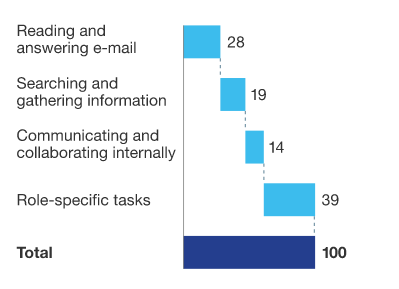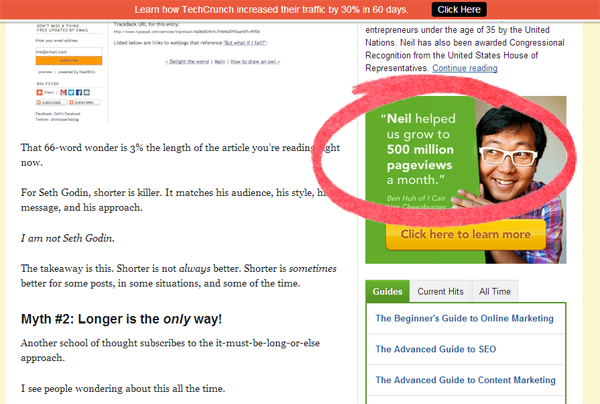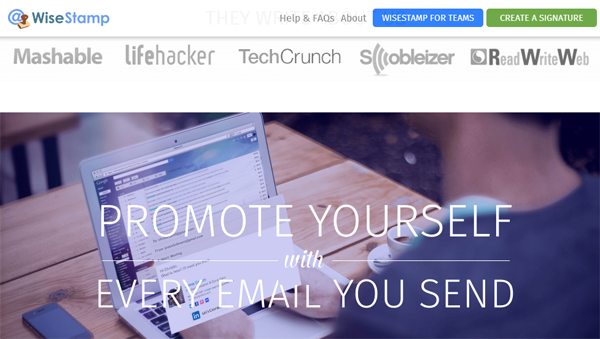I know.
Emails suck.
Well, not really, but with more than 294 billion emails sent daily, your inbox can be one of the worst parts of your day.
Except maybe blogging.
Am I right?
Well, it’s time to put an end to that and kill two birds with one stone.
Every email is a piece of content, which is why it’s possible to turn your inbox nightmare into a content marketing machine.
I promise.
Simply follow these 5 things…
Curate Your Thoughts
An email should follow the cardinal rule of creating great content – curation.
Chances are you’ve never thought about “curating your emails” before, yet that’s exactly what you’re doing. You’re creating a piece of content (email) for a purpose (marketing goal) that you hope to achieve by getting someone to respond to something (an action item).
The average person sends and receives 120 emails a day. If yours isn’t curated properly, it will have a harder time capturing someone’s attention and getting them to respond.
Plus, curating emails is good practise, which you can leverage into other aspects of your content campaign.
So, here are some easy email tips to follow:
- Less is more.
- Just like we discussed last week, keep your writing simple.
- Make it easy to read.
- Break up your thoughts with spaces. (If a paragraph in an email is longer than 3 sentences, chances are it will get skipped.)
- Free free to use bold to highlight one or two key things. (This works well for dates and numbers.)
- Have a clear action item.
- Have a clear action item. This one gets repeated twice because it’s that important. Make the purpose of your email clear, and make the action item for your recipient clear too.
- If it’s a long message, pick up the phone. The average person spends 28% of their day in their inbox. Image how much time you could save if you followed up matters using the phone.
Practise Makes Perfect
The more you practise writing simply and clearly, the easier it will be when you blog.
People often postpone blogging because they don’t have ideas or they feel they can’t write. But if you think about it, we send 120 emails a day.
According to the 2013 Email Marketing Benchmark Study, the average email is 15.9 KG. Considering an 80 word plain text email is about 10 KG, the average email is less than 160 words.
If you do the math, we’re writing an average of 19,200 words a day, or roughly nine 2,000 word blog posts or nineteen 1,000 word ones.
Sure, this is an average.
Many emails are a few words long. However, the key is that you are creating a lot more content than you realize.
While the content is different than a blog post, you can build a solid writing foundation by practising and refining your skills everyday.
Practise makes perfect.
And when you’re running a small business, this practise can increase your sales.
Save The Good Stuff
When you’re responding to a popular customer question, save it as a canned response.
A canned response is like an email draft that you can modify and send again as many times as you like.
That way, when someone asks you a popular question again, you’ll save 5 minutes by simply responding using the canned response, and modifying a word or two.
Like all good content tricks, the key is automation. The goal is to streamline the process to shave off as many minutes as possible.
Most major email providers have canned responses. If you’re using Gmail, you can see how to add canned responses here. And if you use a platform for managing customer support, chances are they’ll have a canned response function too.
Do yourself a favour. Find it and start using it.
- If you have an extra hour, be proactive and set up messages to 5 of the most popular questions you get.
- If you’re busy, simply create canned responses to common questions as they arise.
Once again, keep the canned email short, sweet and personal.
Canned response doesn’t mean formal.
It means fast.
Tag Your “Testimonials”
Anytime someone says something nice about you and your business in an email, tag it or put it in a “Testimonials” folder so you can easily access it.
Testimonials are great.
Not only do they make you feel good, they’re a perfect nugget of content because they add validation and proof, which helps build trust. (As you know, these are essential to successful content campaigns.)
The cool thing about testimonials is that they aren’t just for your homepage or a case study.
Because they validate who you are, why not include them in your blog – either on the sidebar or at the end of your post? Somewhere your fans can see them.
You can even showcase testimonials in a HelloBar on your website, and use it to guide your readers to a landing page with a customer success story and encourage them to follow up with you.
p.s. Not convinced that testimonials on your blog will help? Read this.
Showcase Your Content Where It Counts
Sure, you promote your blog, but do you promote it in the most popular area?
You send and receive a lot of emails a day. That’s a lot of personalized communication. So, why not showcase your blog post in your signature? Chances are it will resonate with some of the people you’re chatting with.
And…
It works.
Bloggers Nikki and LeighAnn recently wrote about how it’s helping them grow their readership. And Unilever went from 40,000 to 235,000 subscribers in just 10 months after putting a link in their email signature.
Content marketing is all about automation (didn’t we just cover that?!).
So, if you’re going to add your most recent post to your email signature, trying using a free app like WiseStamp, which will do it automatically for you.
WiseStamp is easy to set up, works will most major email providers and has already been included in over 640 million emails!
Like all good marketing touch points, your email signature should have one call to action. For example, “Check out our latest post.”
If you also want to direct people to recent press or to try a demo of your product, then have the press link or the demo link for a week instead of your blog post. Because like over doing it at a buffet, the worst thing you can do is make your signature area bloated…
Hey, “Check out our latest post” and “Read about all the press we’re featured in” and “Like us on Facebook and Twitter” and…
One clear action is better than 10 failed ones.
Final Thoughts: Make Your Inbox Work For You
Inboxes can be frustrating.
But they’re also one of the best opportunities to refine your content strategy and start converting more prospects into partners, customers and of course, sales.
One of the best posts I’ve read on hacking emails is by a friend of ours that runs Vero. You should read it, it’s better than what we just wrote.





